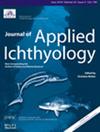Acoustic Target Strength of Jellyfish, Nemopilema nomurai, Measured at Multi-Frequency and Multi-Orientation
Abstract
The jellyfish Nemopilema nomurai occupies an important position in the Northwest Pacific ecosystem, and monitoring its biomass is necessary to ensure the protection of fishery resources and the safety of offshore industrial production. The acoustic method has been proposed for jellyfish flux estimation and bloom warning, in which the target strength (TS) of the jellyfish is a crucial parameter. However, varied swimming orientations of jellyfish aggregation result in different backscatter strengths. The acoustic echo characteristics in horizontal swimming orientations and multi-frequency broadband signals are yet to be revealed. This study aims to obtain the TS of jellyfish in various orientations and to comprehensively investigate the jellyfish acoustic echo features at various frequency broadband sounds. In an anechoic tank, we used wide-band echosounder and 70 kHz, 120 kHz, and 200 kHz split-beam transducers to measure the TS of jellyfish swimming omnidirectionally. The results show a difference of approximately 4 dB in the jellyfish’s normalized TS at 70 kHz (frequency range: 45 kHz to 95 kHz) and 200 kHz (frequency range: 160 kHz to 260 kHz) center frequency. The normalized TS of jellyfish varies by around 8 dB between horizontal and vertical swimming orientations. For jellyfish swimming horizontally, the TS and bell diameter have the following least squares fits: TSD70kHz = 20 log D − 89.36(r2 = 0.83); TSD200kHz = 20 log D − 93.85(r2 = 0.83). The swimming orientation has significant effects on TS estimation and model construction.


 求助内容:
求助内容: 应助结果提醒方式:
应助结果提醒方式:


